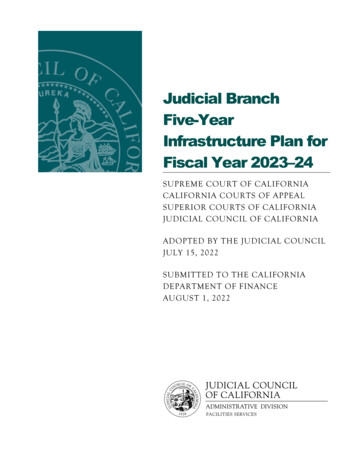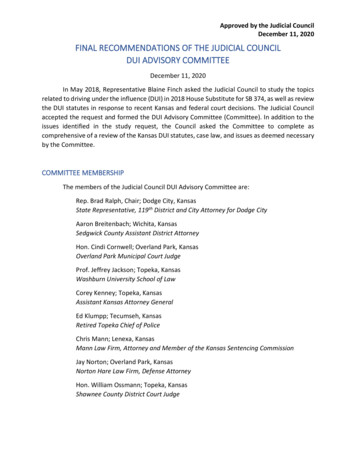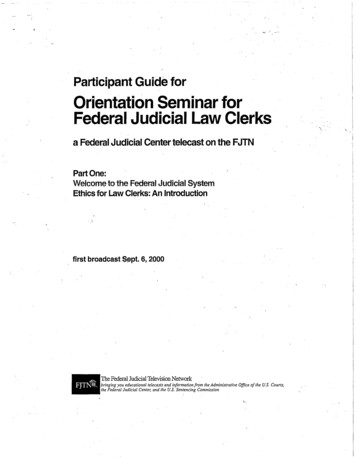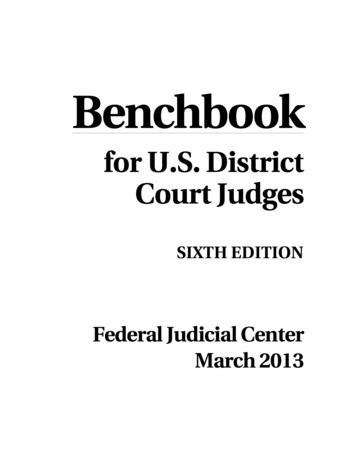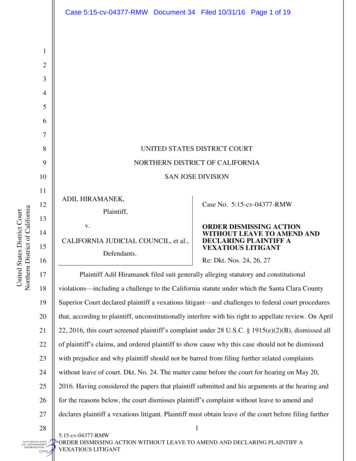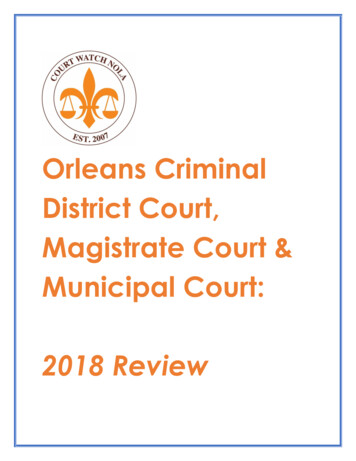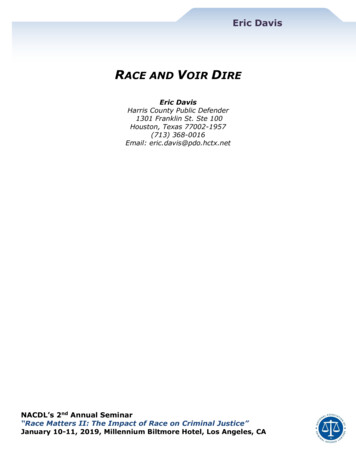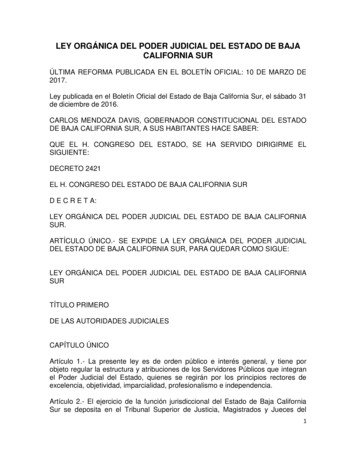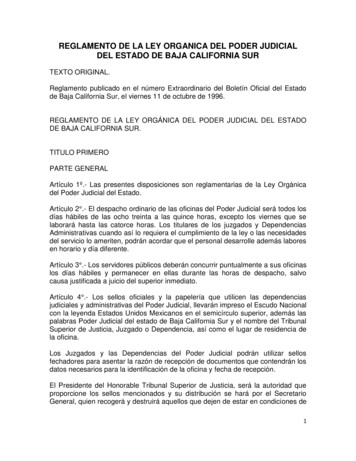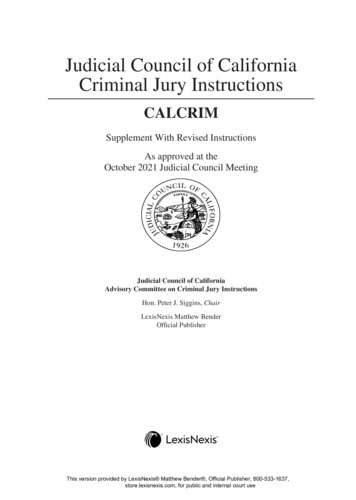
Transcription
Judicial Council of CaliforniaCriminal Jury InstructionsCALCRIMSupplement With Revised InstructionsAs approved at theOctober 2021 Judicial Council MeetingJudicial Council of CaliforniaAdvisory Committee on Criminal Jury InstructionsHon. Peter J. Siggins, ChairLexisNexis Matthew BenderOfficial PublisherThis version provided by LexisNexis Matthew Bender , Official Publisher, 800-533-1637,store.lexisnexis.com, for public and internal court use
QUESTIONS ABOUT THIS PUBLICATION?For questions about the Editorial Content appearing in these volumes or reprint permission, please call:Valri J. Nesbit, J.D., LL.M. at . 1-415-908-3343Email: . cal.custquest@lexisnexis.comOutside the United States and Canada, please call . . . . . . . . . . . . . . . . . . . . . . . . (973) 820-2000For assistance with replacement pages, shipments, billing or other customer service matters, please call:Customer Services Department at . . . . . . . . . . . . . . . . . . . . . . . . . . . . . . . . . . . (800) 833-9844Outside the United States and Canada, please call . . . . . . . . . . . . . . . . . . . . . . . . (518) 487-3385Fax Number . . . . . . . . . . . . . . . . . . . . . . . . . . . . . . . . . . . . . . . . . . . . . . . . . (800) 828-8341Customer Service Website . . . . . . . . . . . . . . . . . . . . . . . . . . http://www.lexisnexis.com/custserv/For information on other Matthew Bender publications, please callYour account manager or . . . . . . . . . . . . . . . . . . . . . . . . . . . . . . . . . . . . . . . . (800) 223-1940Outside the United States and Canada, please call . . . . . . . . . . . . . . . . . . . . . . . . . (937) 247-0293ISSN 1557-1378ISBN 978-1-5221-8548-2 (print) 2021 by the Judicial Council of California. No copyright is claimed in the Tables of Related Instructions, Table ofCases, Table of Statutes, or Index. 2021, Matthew Bender & Company, Inc., a member of the LexisNexis Group. No copyright is claimed to the text ofthe jury instructions, bench notes, authority, other Task Force and Advisory Committee commentary, or references tosecondary sources.CITE THIS SUPPLEMENT: Judicial Council of California Criminal Jury Instructions (October 2021supp.)Cite these instructions: “CALCRIM No. .”Editorial Office230 Park Ave., 7th Floor, New York, NY 10169 (800) 543-6862www.lexisnexis.com(10/2021–Pub.1284)This version provided by LexisNexis Matthew Bender , Official Publisher, 800-533-1637,store.lexisnexis.com, for public and internal court use
Table of Revised Judicial Council ofCalifornia Criminal Jury Instructions(CALCRIM)October 2021This Supplement of CALCRIM includes all of the revised Judicial Council of CaliforniaCriminal Jury Instructions approved by the Judicial Council of California at its October 2021meeting.EvidenceCALCRIM No. 336. In-Custody Informant (revised)Aiding and AbettingCALCRIM NO. 417. Liability for Coconspirators’ Acts (revised)HomicideCALCRIM No. 582. Involuntary Manslaughter: Failure to Perform Legal Duty—Murder Not Charged(Pen. Code, § 192(b)) (revised)CALCRIM No. 625. Voluntary Intoxication: Effects on Homicide Crimes (Pen. Code, § 29.4) (revised)CALCRIM No. 775. Death Penalty: Intellectual Disability (Pen. Code, § 1376) (revised)Assaultive and Battery CrimesCALCRIM No. 840. Inflicting Injury on Spouse, Cohabitant, or Fellow Parent Resulting in TraumaticCondition (Pen. Code, § 273.5(a)) (revised)CALCRIM No. 852A. Evidence of Uncharged Domestic Violence (revised)Sex OffensesCALCRIM No. 1001. Rape or Spousal Rape in Concert (Pen. Code, § 264.1) (revised)CALCRIM No. 1015. Oral Copulation by Force, Fear, or Threats (Pen. Code, § 287(c)(2) & (3), (k))(revised)CALCRIM No. 1016. Oral Copulation in Concert (Pen. Code, § 287(d)) (revised)CALCRIM No. 1030. Sodomy by Force, Fear, or Threats (Pen. Code, § 286(c)(2), (3), (k)) (revised)CALCRIM No. 1031. Sodomy in Concert (Pen. Code, § 286(d)) (revised)CALCRIM No. 1045. Sexual Penetration by Force, Fear, or Threats (Pen. Code, § 289(a)(1), (2), (g))(revised)CALCRIM No. 1046. Sexual Penetration in Concert (Pen. Code, §§ 264.1, 289(a)(1)) (revised)KidnappingCALCRIM No. 1201. Kidnapping: Child or Person Incapable of Consent (Pen. Code, § 207(a), (e))(revised)CALCRIM No. 1215. Kidnapping (Pen. Code, § 207(a)) (revised)CALCRIM No. 1243. Human Trafficking (Pen. Code, § 236.1(a) & (b)) (revised)CALCRIM No. 1244. Causing Minor to Engage in Commercial Sex Act (Pen. Code, § 236.1(c)) (revised)iiiThis version provided by LexisNexis Matthew Bender , Official Publisher, 800-533-1637,store.lexisnexis.com, for public and internal court use
TheftCALCRIM No. 1807. Theft From Elder or Dependent Adult (Pen. Code, § 368(d), (e)) (revised)Criminal Writings and FraudCALCRIM No. 1930. Possession of Forged Document (Pen. Code, § 475(a)) (revised)CALCRIM No. 2045. False Personation (Pen. Code, § 530) (new)Vehicle OffensesCALCRIM No. 2100. Driving a Vehicle or Operating a Vessel Under the Influence Causing Injury (Veh.Code, § 23153(a), (f), (g)) (revised)CALCRIM No. 2200. Reckless Driving (Veh. Code, § 23103(a) & (b)) (revised)Crimes Against the GovernmentCALCRIM No. 2656. Resisting Peace Officer, Public Officer, or EMT (Pen. Code, § 148(a)) (revised)Enhancements and Sentencing FactorsCALCRIM No. 3185. Sex Offenses: Sentencing Factors—Using Force or Fear Against Minor Under 14Years/14 Years or Older (Pen. Code, §§ 264.1(b), 286(c)(2)(B)&(C), 286(d)(2)&(3), 287(c)(2)(B)&(C),287(d)(2)&(3), 289(a)(1)(B)&(C)) (new)Defenses and InsanityCALCRIM No. 3411. Mistake of Law As a Defense (revised)CALCRIM No. 3451. Present Mental Competence of Defendant (revised)ivThis version provided by LexisNexis Matthew Bender , Official Publisher, 800-533-1637,store.lexisnexis.com, for public and internal court use
336. In-Custody InformantView the (statement/ [or] testimony) of an in-custody informant againstthe defendant with caution and close scrutiny. In evaluating such (astatement/ [or] testimony), you should consider the extent to which itmay have been influenced by the receipt of, or expectation of, anybenefits. This does not mean that you may arbitrarily disregard such(statement/ [or] testimony), but you should give it the weight to whichyou find it to be entitled in the light of all the evidence in the case. Give the following paragraph if the issue of whether a witness was an incustody informant is in dispute [An in-custody informant is someone [, other than (a/an) (codefendant[,]/[or] percipient witness[,]/ [or] accomplice[,]/ [or] coconspirator,)] whose(statement/ [or] testimony) is based on [a] statement[s] the defendantallegedly made while both the defendant and the informant were heldwithin a correctional institution. If you decide that a (declarant/ [or]witness) was not an in-custody informant, then you should evaluate hisor her (statement/ [or] testimony) as you would that of any otherwitness.] Give the first bracketed phrase if the issue of whether a witness was anin-custody informant is in dispute [If you decide that a (declarant/ [or] witness) was an in-custodyinformant, then] (Y/)you may not convict the defendant of insert charged crime[s] based on the (statement/ [or] testimony) of thatin-custody informant alone. [Nor may you find a special circumstancetrue/ [or] use evidence in aggravation based on the (statement/ [or]testimony) of that in-custody informant alone.]You may use the (statement/ [or] testimony) of an in-custody informantagainst the defendant only if:1. The (statement/ [or] testimony) is supported by other evidencethat you believe;2. That supporting evidence is independent of the (statement/ [or]testimony);AND3. That supporting evidence connects the defendant to thecommission of the crime[s] [or to the special circumstance/ [or] toevidence in aggravation]. The supporting evidence is not sufficient1Copyright Judicial Council of California
CALCRIM No. 336if it merely shows that the charged crime was committed [orproves the existence of a special circumstance/ [or] evidence inaggravation].This supporting evidence requirement does not apply where thetestimony of an in-custody informant is offered for any purpose otherthan proving (guilt/ [or] a special circumstance/evidence in aggravation).[Supporting evidence, however, may be slight. It does not need to beenough, by itself, to prove that the defendant is guilty of the chargedcrime, and it does not need to support every fact (mentioned by theaccomplice in the statement/ [or] about which the witness testified). Onthe other hand, it is not enough if the supporting evidence merely showsthat a crime was committed or the circumstances of its commission. Thesupporting evidence must tend to connect the defendant to thecommission of the crime.][Do not use the (statement/ [or] testimony) of an in-custody informant tosupport the (statement/ [or] testimony) of another in-custody informantunless you are convinced that insert name of party callingin-custody informant as witness has proven it is more likely than not thatthe in-custody informant has not communicated with another in-custodyinformant on the subject of the testimony.][A percipient witness is someone who personally perceived the matterthat he or she testified about.] Insert the name of the in-custody informant if his or her statement is not indispute [ insert name of witness is an in-custody informant.][ insert name of institution is a correctional institution.]New January 2006; Revised August 2012, February 2016, October 2021BENCH NOTESInstructional DutyThe court must give this instruction on request. (Pen. Code, § 1127a.)The court should also be aware of the following statutory provisions relating to incustody informants: Penal Code sections 1127a(c) [prosecution must discloseconsideration given to witness]; 1191.25 [prosecution must notify victim of incustody informant]; and 4001.1 [limitation on payments to in-custody informantsand action that may be taken by in-custody informant].If there is no issue over whether the witness is an in-custody informant and theparties agree, the court may instruct the jury that the witness “is an in-custodyinformant.” If there is an issue over whether the witness is an in-custody informant,give the bracketed definition of the term.2Copyright Judicial Council of California
CALCRIM No. 336The committee awaits guidance from courts of review on the issue of whether thisinstruction applies to witnesses other than those called by the People. Until the issueis resolved, the committee provides this version consistent with the language of thenew statute.If the court concludes that the corroboration requirement applies to an out-of-courtstatement, use the word “statement” throughout the instruction. (See discussion inRelated Issues section to CALCRIM No. 334, Accomplice Testimony Must BeCorroborated: Dispute Whether Witness Is Accomplice.)Related InstructionCALCRIM No. 337, Witness in Custody or Physically Restrained.AUTHORITY Instructional Duty.Pen. Code, §§ 1111.5, 1127a. In-Custody Informant Testimony and Accomplice Testimony May CorroborateEach Other. People v. Huggins (2015) 235 Cal.App.4th 715, 719–720 [185Cal.Rptr.3d 672].SECONDARY SOURCES2 Witkin, California Evidence (5th ed. 2012) Witnesses, § 20.3 Witkin, California Evidence (5th ed. 2012) Presentation at Trial, §§ 120, 123.2 Millman, Sevilla & Tarlow, California Criminal Defense Practice, Ch. 30,Confessions and Admissions, § 30.32[2] (Matthew Bender).4 Millman, Sevilla & Tarlow, California Criminal Defense Practice, Ch. 82,Witnesses, § 82.03A, Ch. 85, Submission to Jury and Verdict, §§ 85.02[2][b],85.03[2][b] (Matthew Bender).3Copyright Judicial Council of California
417. Liability for Coconspirators’ ActsA member of a conspiracy is criminally responsible for the crimes thathe or she conspires to commit, no matter which member of theconspiracy commits the crime.A member of a conspiracy is also criminally responsible for any act ofany member of the conspiracy if that act is done to further theconspiracy and that act is a natural and probable consequence of thecommon plan or design of the conspiracy. This rule applies even if theact was not intended as part of the original plan. [Under this rule, adefendant who is a member of the conspiracy does not need to bepresent at the time of the act.]A natural and probable consequence is one that a reasonable personwould know is likely to happen if nothing unusual intervenes. Indeciding whether a consequence is natural and probable, consider all ofthe circumstances established by the evidence.A member of a conspiracy is not criminally responsible for the act ofanother member if that act does not further the common plan or is not anatural and probable consequence of the common plan.To prove that the defendant is guilty of the crime[s] charged in Count[s], the People must prove that:1. The defendant conspired to commit one of the following crimes: insert target crime[s] ;2. A member of the conspiracy committednontarget offense[s] to further the conspiracy; insertAND3. insert nontarget offense[s] (was/were) [a] naturaland probable consequence[s] of the common plan or design of thecrime that the defendant conspired to commit.[The defendant is not responsible for the acts of another person who wasnot a member of the conspiracy even if the acts of the other personhelped accomplish the goal of the conspiracy.][A conspiracy member is not responsible for the acts of other conspiracymembers that are done after the goal of the conspiracy had beenaccomplished.]New January 2006; Revised October 20214Copyright Judicial Council of California
CALCRIM No. 417BENCH NOTESInstructional DutyGive this instruction when there is an issue whether the defendant is liable for theacts of coconspirators. (See People v. Flores (1992) 7 Cal.App.4th 1350, 1363 [9Cal.Rptr.2d 754] [no sua sponte duty when no issue of independent criminal act bycoconspirator].)The court must also give either CALCRIM No. 415, Conspiracy, or CALCRIM No.416, Evidence of Uncharged Conspiracy, with this instruction. The court must alsogive all appropriate instructions on the offense or offenses alleged to be the target ofthe conspiracy. (People v. Prettyman (1996) 14 Cal.4th 248, 254 [58 Cal.Rptr.2d827, 926 P.2d 1013].)Give the bracketed sentence that begins with “Under this rule,” if there is evidencethat the defendant was not present at the time of the act. (See People v. Benenato(1946) 77 Cal.App.2d 350, 356 [175 P.2d 296]; People v. King (1938) 30Cal.App.2d 185, 203 [85 P.2d 928].)Although no published case to date gives a clear definition of the terms “natural”and “probable,” nor holds that there is a sua sponte duty to define them, a suggesteddefinition is included. (See People v. Prettyman (1996) 14 Cal.4th 248, 291 [58Cal.Rptr.2d 827, 926 P.2d 1013] (conc. & dis. opn. of Brown, J.).)Give either of the last two bracketed paragraphs on request, when supported by theevidence.Related InstructionsCALCRIM No. 418, Coconspirator’s Statements.AUTHORITY Natural and Probable Consequences; Reasonable Person Standard. People v.Superior Court (Shamis) (1997) 58 Cal.App.4th 833, 842–843 [68 Cal.Rptr.2d388]; see People v. Nguyen (1993) 21 Cal.App.4th 518, 531 [26 Cal.Rptr.2d 323][in context of aiding and abetting]. Vicarious Liability of Conspirators. People v. Hardy (1992) 2 Cal.4th 86, 188[5 Cal.Rptr.2d 796, 825 P.2d 781]. Must Identify and Describe Target Offense. People v. Prettyman (1996) 14Cal.4th 248, 254 [58 Cal.Rptr.2d 827, 926 P.2d 1013].RELATED ISSUESMurderA verdict of murder may not be based on the natural and probable consequencesdoctrine. Pen. Code, § 188(a)(3). (Penal Code section 188, as amended by Statutes2018, ch. 1015 (S.B. 1437), became effective January 1, 2019.) The amendmentadded “malice shall not be imputed to a person based solely on his or herparticipation in a crime.” The question of whether this amendment abolished thenatural and probable consequences doctrine as to attempted murder is unresolved.5Copyright Judicial Council of California
CALCRIM No. 417SECONDARY SOURCES1 Witkin & Epstein, California Criminal Law (4th ed. 2012) Elements, §§ 98–99.6 Millman, Sevilla & Tarlow, California Criminal Defense Practice, Ch. 141,Conspiracy, Solicitation, and Attempt, §§ 141.01[6], 141.02 (Matthew Bender).6Copyright Judicial Council of California
582. Involuntary Manslaughter: Failure to Perform LegalDuty—Murder Not Charged (Pen. Code, § 192(b))The defendant is charged [in Count] with involuntarymanslaughter [in violation of Penal Code section 192(b)] based on failureto perform a legal duty.To prove that the defendant is guilty of this crime, the People mustprove that:1. The defendant had a legal duty todecedent ; insert name of2. The defendant failed to perform that legal duty;3. The defendant’s failure was criminally negligent;AND4. The defendant’s failure caused the death ofname of decedent . insert(A/An) insert description of person owing duty has a legalduty to (help/care for/rescue/warn/maintain the property of/ insert other required action[s] ) insert description ofdecedent, not name .Criminal negligence involves more than ordinary carelessness,inattention, or mistake in judgment. A person acts with criminalnegligence when:1. He or she acts in a reckless way that creates a high risk of deathor great bodily injury;AND2. A reasonable person would have known that acting in that waywould create such a risk.In other words, a person acts with criminal negligence when the way heor she acts is so different from how an ordinarily careful person wouldact in the same situation that his or her act amounts to disregard forhuman life or indifference to the consequences of that act.[Great bodily injury means significant or substantial physical injury. It isan injury that is greater than minor or moderate harm.][An act causes death if the death is the direct, natural, and probableconsequence of the act and the death would not have happened withoutthe act. A natural and probable consequence is one that a reasonableperson would know is likely to happen if nothing unusual intervenes. In7Copyright Judicial Council of California
CALCRIM No. 582deciding whether a consequence is natural and probable, consider all ofthe circumstances established by the evidence.][There may be more than one cause of death. An act causes death, onlyif it is a substantial factor in causing the death. A substantial factor ismore than a trivial or remote factor. However, it does not need to be theonly factor that causes the death.]New January 2006; Revised September 2020, October 2021BENCH NOTESInstructional DutyThe court has a sua sponte duty to give this instruction defining the elements of thecrime.The second sentence of the great bodily injury definition could result in error if theprosecution improperly argues great bodily injury may be shown by greater thanminor injury alone. (Compare People v. Medellin (2020) 45 Cal.App.5th 519,533–535 [258 Cal.Rptr.3d 867] [the definition was reasonably susceptible toprosecutor’s erroneous argument that the injury need only be greater than minor]with People v. Quinonez (2020) 46 Cal.App.5th 457, 466 [260 Cal.Rptr.3d 86][upholding instructions containing great bodily injury definition as written].)Legal DutyThe existence of a legal duty is a matter of law to be decided by the judge.(Kentucky Fried Chicken v. Superior Court (1997) 14 Cal.4th 814, 819 [59Cal.Rtpr.2d 756, 927 P.2d 1260]; Isaacs v. Huntington Memorial Hospital (1985) 38Cal.3d 112, 124 [211 Cal.Rptr. 356, 695 P.2d 653].) The court should instruct thejury if a legal duty exists. (See People v. Burden (1977) 72 Cal.App.3d 603, 614[140 Cal.Rptr. 282] [proper instruction that parent has legal duty to furnishnecessary clothing, food, and medical attention for his or her minor child].) In theinstruction on legal duty, the court should use generic terms to describe therelationship and duty owed. For example:A parent has a legal duty to care for a child.A paid caretaker has a legal duty to care for the person he or she was hired tocare for.A person who has assumed responsibility for another person has a legal duty tocare for that other person.The court should not state “the defendant had a legal duty to the decedent.” (SeePeople v. Brown (1988) 46 Cal.3d 432, 444–445 [250 Cal.Rptr. 604, 758 P.2d 1135][correct to state “a Garden Grove Regular Police Officer [is a] peace officer”; wouldbe error to state “Officer Reed was a peace officer”].)However, in a small number of cases where the legal duty to act is based on thedefendant having created or increased risk to the victim, the existence of the legal8Copyright Judicial Council of California
CALCRIM No. 582duty may depend on facts in dispute. (See People v. Oliver (1989) 210 Cal.App.3d138, 149 [258 Cal.Rptr. 138].) If there is a conflict in testimony over the factsnecessary to establish that the defendant owed a legal duty to the victim, then theissue must be submitted to the jury. In such cases, the court should insert a sectionsimilar to the following:The People must prove that the defendant had a legal duty to (help/rescue/warn/ insert other required action[s] ) insertname of decedent .In order to prove that the defendant had this legal duty, the People mustprove that the defendant insert facts that establish legalduty .If you decide that the People have proved that the defendant insert facts that establish legal duty , then the defendant had a legal dutyto (help/rescue/warn/ insert other required action[s] ) insert name of decedent .If you have a reasonable doubt whether the defendant insertfacts that establish legal duty , then you must find (him/her) not guilty.AUTHORITY Elements. Pen. Code, § 192(b); People v. Oliver (1989) 210 Cal.App.3d 138,146 [258 Cal.Rptr. 138].Criminal Negligence. People v. Penny (1955) 44 Cal.2d 861, 879–880 [285P.2d 926]; People v. Rodriguez (1960) 186 Cal.App.2d 433, 440 [8 Cal.Rptr.863].Legal Duty. People v. Heitzman (1994) 9 Cal.4th 189, 198–199 [37Cal.Rptr.2d 236, 886 P.2d 1229]; People v. Oliver (1989) 210 Cal.App.3d 138,149 [258 Cal.Rptr. 138].Causation. People v. Roberts (1992) 2 Cal.4th 271, 315–321 [6 Cal.Rptr.2d276, 826 P.2d 274].This Instruction Upheld. People v. Skiff (2021) 59 Cal.App.5th 571, 579–580[273 Cal.Rptr.3d 572].LESSER INCLUDED OFFENSESAggravated assault is not a lesser included offense of involuntary manslaughter.(People v. Murray (2008) 167 Cal.App.4th 1133, 1140 [84 Cal.Rptr.3d 676].)RELATED ISSUESLegal Duty to AidIn People v. Oliver (1989) 210 Cal.App.3d 138, 147 [258 Cal.Rptr. 138], the courtexplained the requirement of a legal duty to act as follows:A necessary element of negligence, whether criminal or civil, is a duty owed tothe person injured and a breach of that duty . . . . Generally, one has no legalduty to rescue or render aid to another in peril, even if the other is in danger of9Copyright Judicial Council of California
CALCRIM No. 582losing his or her life, absent a special relationship which gives rise to suchduty . . . . In California civil cases, courts have found a special relationshipgiving rise to an affirmative duty to act where some act or omission on the partof the defendant either created or increased the risk of injury to the plaintiff, orcreated a dependency relationship inducing reliance or preventing assistancefrom others . . . . Where, however, the defendant took no affirmative actionwhich contributed to, increased, or changed the risk which would otherwisehave existed, and did not voluntarily assume any responsibility to protect theperson or induce a false sense of security, courts have refused to find a specialrelationship giving rise to a duty to act.Duty Based on Dependency/Voluntary Assumption of ResponsibilityA legal duty to act exists when the defendant is a caretaker or has voluntarilyassumed responsibility for the victim. (Walker v. Superior Court (1988) 47 Cal.3d112, 134–138 [253 Cal.Rptr. 1, 763 P.2d 852] [parent to child]; People v. Montecino(1944) 66 Cal.App.2d 85, 100 [152 P.2d 5] [contracted caretaker to dependent].)Duty Based on Conduct Creating or Increasing RiskA legal duty to act may also exist where the defendant’s behavior created orsubstantially increased the risk of harm to the victim, either by creating thedangerous situation or by preventing others from rendering aid. (People v. Oliver(1989) 210 Cal.App.3d 138, 147–148 [258 Cal.Rptr. 138] [defendant had duty to actwhere she drove victim to her home knowing he was drunk, knowingly allowed himto use her bathroom to ingest additional drugs, and watched him collapse on thefloor]; Sea Horse Ranch, Inc. v. Superior Court (1994) 24 Cal.App.4th 446, 456 [30Cal.Rptr.2d 681] [defendant had duty to prevent horses from running onto adjacentfreeway creating risk].)SECONDARY SOURCES1 Witkin & Epstein, California Criminal Law (4th ed. 2012) Crimes Against thePerson, §§ 258–260.6 Millman, Sevilla & Tarlow, California Criminal Defense Practice, Ch. 140,Challenges to Crimes, §§ 140.03, 140.04, Ch. 142, Crimes Against the Person,§ 142.02[2][b] (Matthew Bender).10Copyright Judicial Council of California
625. Voluntary Intoxication: Effects on Homicide Crimes (Pen.Code, § 29.4)You may consider evidence, if any, of the defendant’s voluntaryintoxication only in a limited way. You may consider that evidence onlyin deciding whether the defendant acted with an intent to kill[,] [or] [thedefendant acted with deliberation and premeditation[,]] [[or] thedefendant was unconscious when (he/she) acted[,]] [or the defendant insert other specific intent required in a homicide charge orother charged offense .]A person is voluntarily intoxicated if he or she becomes intoxicated bywillingly using any intoxicating drug, drink, or other substance knowingthat it could produce an intoxicating effect, or willingly assuming therisk of that effect.You may not consider evidence of the defendant’s voluntary intoxicationfor any other purpose.New January 2006; Revised August 2014, February 2016, March 2019, October2021BENCH NOTESInstructional DutyWith the statutory elimination of diminished capacity as a defense, there is no suasponte duty to instruct on the effect of voluntary intoxication on the mental statesrequired for homicide. (Pen. Code, § 28(b); People v. Saille (1991) 54 Cal.3d 1103,1119–1120 [2 Cal.Rptr.2d 364, 820 P.2d 588].) However, subsequent cases affirmthat voluntary intoxication can be used to negate an element of the crime that mustbe proven by the prosecution. (People v. Reyes (1997) 52 Cal.App.4th 975, 982 [61Cal.Rptr.2d 39]; People v. Visciotti (1992) 2 Cal.4th 1, 56–57 [5 Cal.Rptr.2d 495,825 P.2d 388].) Such an instruction is a “pinpoint” instruction, which must be givenon request when there is sufficient evidence supporting the theory. (People v. Saille,supra, 54 Cal.3d at p. 1120.)Include the bracketed language regarding unconsciousness if the court also givesCALCRIM No. 626, Voluntary Intoxication Causing Unconsciousness: Effects onHomicide Crimes.If the defendant is charged with a homicide crime that has as an element anadditional specific intent requirement other than intent to kill, include the requiredintent in the last bracketed portion of the second sentence. For example, if thedefendant is charged with torture murder, include “whether the defendant intendedto inflict extreme and prolonged pain.” Or, if the defendant is charged with felonymurder, insert intent to commit the felony where indicated. Similarly, if thedefendant is also charged with a nonhomicide crime with a specific intent11Copyright Judicial Council of California
CALCRIM No. 625requirement, include that intent requirement. For example, if the defendant ischarged with murder and robbery, include “whether the defendant intended topermanently deprive the owner of the property.”Evidence of voluntary intoxication is inadmissible on the question of whether adefendant believed it necessary to act in self-defense. (People v. Soto (2018) 4Cal.5th 968, 970 [231 Cal.Rptr.3d 732, 415 P.3d 789].)AUTHORITY Voluntary Intoxication Defined.Pen. Code, § 29.4(c). Unconsciousness Not Required. People v. Ray (1975) 14 Cal.3d 20, 28–29[120 Cal.Rptr. 377, 533 P.2d 1017], disapproved on other grounds in People v.Blakeley (2000) 23 Cal.4th 82, 89 [96 Cal.Rptr.2d 451, 999 P.2d 675]. No Sua Sponte Duty to Instruct. People v. Saille (1991) 54 Cal.3d 1103, 1120[2 Cal.Rptr.2d 364, 820 P.2d 588]. Evidence of Intoxication Inapplicable to Implied Malice. Pen. Code, § 29.4(b);People v. Martin (2000) 78 Cal.App.4th 1107, 1114–1115 [93 Cal.Rptr.2d 433]. Applies to Attempted Murder. People v. Castillo (1997) 16 Cal.4th 1009, 1016[68 Cal.Rptr.2d 648, 945 P.2d 1197]. Voluntary Intoxication Relevant to Knowledge.Cal.App.4th 975, 982–986 [61 Cal.Rptr.2d 39]. This Instruction Upheld. People v. Turk (2008) 164 Cal.App.4th 1361, 1381[80 Cal.Rptr.3d 473]; People v. Timms (2007) 151 Cal.App.4th 1292, 1298 [60Cal.Rptr.3d 677].People v. Reyes (1997) 52RELATED ISSUESGeneral Instruction on Voluntary IntoxicationThis instruction is a specific application of CALCRIM No. 3426, VoluntaryIntoxication, to homicide.UnconsciousnessUnconsciousness (as defined in CALCRIM No. 3425, Unconsciousness) is notrequired. (People v. Ray (1975) 14 Cal.3d 20, 28–29 [120 Cal.Rptr. 377, 533 P.2d1017], disapproved on other grounds in People v. Blakeley (2000) 23 Cal.4th 82, 89[96 Cal.Rptr.2d 451, 999 P.2d 675].)Not Applicable in Murder Cases Based Exclusively on Implied MaliceThis instruction is inapplicable to cases where the murder charge is exclusivelybased on a theory of implied malice because voluntary intoxication can only negateexpress malice. (Pen. Code, § 29.4(b); People v. Martin (2000) 78 Cal.App.4th 1107,1114–1115 [93 Cal.Rptr.2d 433].) Drunk-driving second degree murder is
Mistake of Law As a Defense (revised) CALCRIM No. 3451. Present Mental Competence of Defendant (revised) iv This version provided by LexisNexis Matthew Bender , Official Publisher, 800-533-1637, store.lexisnexis.com, for public and internal court use. 336. In-Custody Informant View the (statement/ [or] testimony) of an in-custody informant against the defendant with caution and close .
